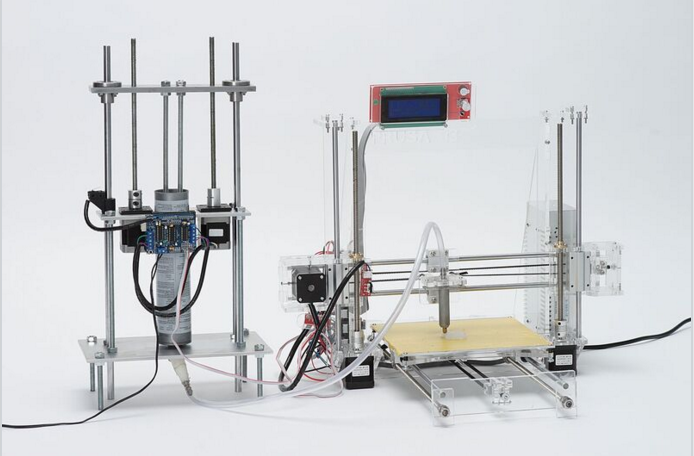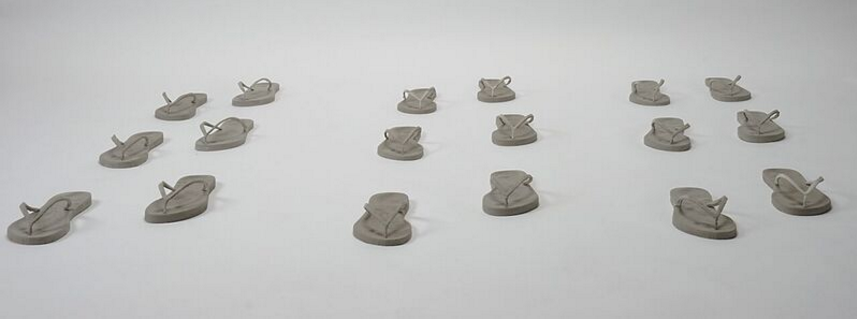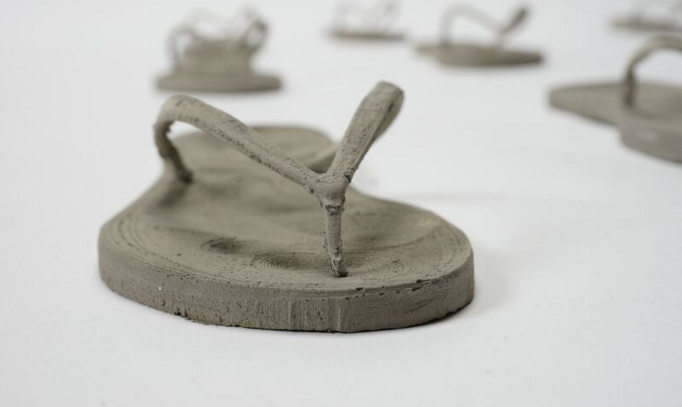 While we highlight many artists involved in the 3D printing process, a select few are completely unforgettable, like German artist Vincent Brinkmann. Known for his astuteness and passion in celebrating the imperfect—and the glitches of technology, Brinkmann has previously shown us a different type of glimpse into the relationship between man and machine, and the intrinsic artifacts and errors found within. Now he is back, with more exploration into the connection that we have with technology and some of its processes. He demonstrates his ideas in Serial 3D Printing with the ‘Flip Flop’ as an example within.
While we highlight many artists involved in the 3D printing process, a select few are completely unforgettable, like German artist Vincent Brinkmann. Known for his astuteness and passion in celebrating the imperfect—and the glitches of technology, Brinkmann has previously shown us a different type of glimpse into the relationship between man and machine, and the intrinsic artifacts and errors found within. Now he is back, with more exploration into the connection that we have with technology and some of its processes. He demonstrates his ideas in Serial 3D Printing with the ‘Flip Flop’ as an example within.
“Since prehistoric times things were copied, rebuilt and rearranged, books were transcribed manually before the invention of the printing press,” Brinkmann told 3DPrint.com. “Reproduction technologies are evolving out of a long history of previous techniques like lithography and photography.”
“The ‘serial 3D printing’ is a contemporary version that is enhanced with a negative silicone mold. Meaning that this negative form is generated based on its digital replica. The printed silicone negative mold is the origin for the subsequent series. As the negative film is the origin for the analogue image the negative silicone mold is the origin for the physically produced series.”
 To illustrate his thoughts regarding serial 3D printing, he created a manifesto which clarifies his main point, explaining that those who are involved in this type of fabrication process are ‘the producer of a series that is generated from digital data.’ They make molds, as he discusses, with the creating act being that of casting objects. Casting becomes a ritual, and Brinkmann points out the overall relationship between man and technology from the casting, to the object, to an actual numbered series which ‘reflects the handling of mass production.’
To illustrate his thoughts regarding serial 3D printing, he created a manifesto which clarifies his main point, explaining that those who are involved in this type of fabrication process are ‘the producer of a series that is generated from digital data.’ They make molds, as he discusses, with the creating act being that of casting objects. Casting becomes a ritual, and Brinkmann points out the overall relationship between man and technology from the casting, to the object, to an actual numbered series which ‘reflects the handling of mass production.’
“Mass production serves as artificial divergence, as the initial point of difference between object and repetition out of which a series is created,” states Brinkmann.
Much of his theme regarding layering, casting, traces of the process, and imperfection are integrated into this work as well.
“Mistakes happen. In the technique of reproduction of serial 3D printing you cast from a mold form; all casts are unique and individual.”
The point of it all is that with serial 3D printing, it in itself becomes a technique that Brinkmann sees spreading and in so doing, finding ‘application.’
With the 3D printed Flip Flop serving as a very good example of a mass-produced article (as a native Floridian, I found his choice of items to be quite genius), Brinkmann is able to show a truly multi-layered symbol as well as a realistic product many people want and can afford, pointing out that for the Western world it represents vacation, a laid-back attitude—and many associate the beach and lazy summertime with this ubiquitous shoe.
“This difference in both symbolic and cultural meaning is what encouraged me to do this serial-produced project,” Brinkmann told 3DPrint.com.
 His 3D printed Flip Flop is definitely just meant to be symbolic, as Brinkmann points out there was not actually a foot used as a prototype, or an actual shoe. He sees it as an insignia for globalization, and many will probably agree that he made a very good choice.
His 3D printed Flip Flop is definitely just meant to be symbolic, as Brinkmann points out there was not actually a foot used as a prototype, or an actual shoe. He sees it as an insignia for globalization, and many will probably agree that he made a very good choice.
“This digital simulation of wearing a Flip Flop out is an absurdity of the digital reproduction process and emphasizes the question of the raison d’être of digital traces in physical objects. 3D printed objects can be distinguished from other products by their layered characteristics representing a unique way of manufacturing.”
Invoking Derrida and the Deconstruction, Brinkmann offers the trace as ‘a witness to action’ and again, going to back to his idea of celebrating imperfections from the process of 3D printing, sees traces as part of the whole technique.
“Manufacturing a series, stereotyping, and trivialization of an object like a Flip Flop just not only poses the question of trace and impact of the reproduction technology ‘serial 3D printing’ but also emphasizes the interaction between the original and the copy.”
As the theme continues, we look forward to seeing Brinkmann’s next works celebrating trace, imperfections, and techniques. As a media artist, Brinkmann studied at the University of Art Bremen and the Academy of Media Arts Cologne. His work, as is obvious, is meant to connect the virtual and physical, and he enjoys creating a connection between code and material, as well as exploring our interactions with technology. His common themes are in that of sculpture, space, and materials.
Subscribe to Our Email Newsletter
Stay up-to-date on all the latest news from the 3D printing industry and receive information and offers from third party vendors.
You May Also Like
NSF Awards Kentucky $1M for Advanced Manufacturing
The National Science Foundation has awarded a $1 million grant to the University of Louisville for the Advancing Manufacturing and Building Construction Technologies (NSF AMT) project. This initiative is part...
3D Printing News Briefs, May 11, 2024: 3D Printed Stent, Tower, Sculptures, & More
We’re starting off with medical research in today’s 3D Printing News Briefs, as researchers in Korea used CT images and 3D printing to fabricate an educational simulator for a mastoidectomy....
3D Printing Unpeeled: Wind Turbines, Probiotics and Lenses
TPI Composites, ORNL and Ingersoll Rand are working to make wind turbine tooling segments that can be 18.3 meters long. These elements also include resistive wires that help keep the...
Tethon 3D Releases Cost-effective Bioprinter
Tethon 3D, known for its ceramic-loaded DLP materials, custom resins, and DLP 3D printers, has recently released a bioprinter. Vat polymerization printers like DLP systems have been widely used by...

































